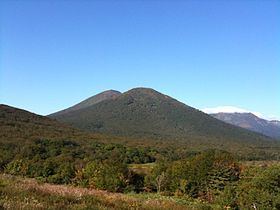Peak Mount Ō Elevation 1,584 m Country Japan Mountain range Ōu Mountains | Parent range Ōu Mountains Orogeny Island arc Highest point Sakasagawadake Type of rock Volcano Mountains Sakasagawadake | |
 | ||
Similar Mount Iwaki, Mount Hachimantai, Mount Osore, Mount Zaō, Mount Iwate | ||
The Hakkōda Mountains (八甲田山系, Hakkōda-sankei) is a volcanic mountain range that lies to the south of Aomori city in Aomori Prefecture, Japan. The range consists of more than a dozen stratovolcanoes and lava domes arranged into two volcanic groups. The Northern Hakkōda Volcanic Group emerges from the rim of an 8-km wide caldera that dates back to the Pleistocene. The Southern Hakkōda Volcanic Group predates the caldera.
Contents
- Map of HakkC58Dda Mountains Aomori Aomori Prefecture Japan
- Description
- Geology
- List of peaks
- Wetlands
- Disaster of the Fifth Infantry Group
- References
Map of Hakk%C5%8Dda Mountains, Aomori, Aomori Prefecture, Japan
Description
The highest peak in the range is Mount Ōdake, which can be climbed from Sukayu Onsen in about four hours. Heavy snowfall makes Hakkoda a prime destination for backcountry and mountain skiers, and there are two mountain huts for overnight trips. The lower slopes of the mountains are forested interspersed with moorland. Above 1300 meters, the Alpine climate zone starts.
The Hakkōda Mountains, along with Lake Towada and the Oirase Valley make up the Towada-Hachimantai National Park.
Geology
The volcanic peaks are made of non-alkali mafic rock; mostly andesite, dacite, and basalt. Although both groups of mountains formed in the Pleistocene, the southern group is older than the northern group. The southern group is made from rock that is 700,000 to 1,700,000 years old, while the northern group is made from rock that is 13,000 to 700,000 years old.
List of peaks
The following is a list of peaks and their heights:
Wetlands
The Hakkōda Mountain are famous for their high-altitude wetlands:
Disaster of the Fifth Infantry Group
The Hakkōda Mountains incident occurred on January 23, 1902, when a group of Imperial Japanese Army soldiers marched in a blizzard on the Hakkōda Mountains en route to Tashiro Hot Spring located in the Hakkōda Mountains. The 199 deaths during a single ascent make it the world's largest mountaineering disaster in the modern history of mountain climbing.
